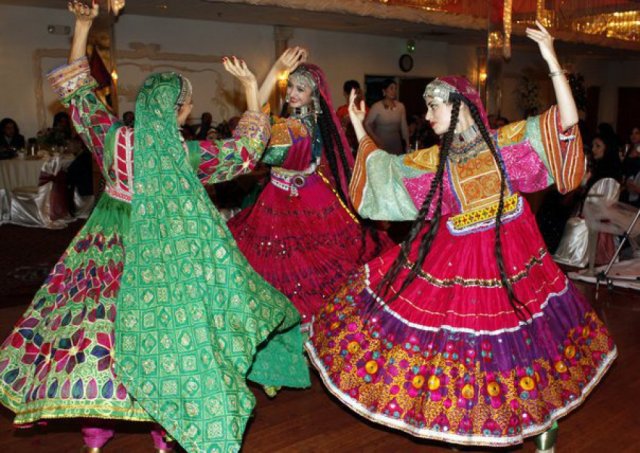
Image: Afghan women dance the national dance, the attan, in their traditional clothing.
Black, red, and green—each color of the flag of Afghanistan holds a significant meaning to the people that call Afghanistan home. Black symbolizes the dark past of a war-ridden nation. Red symbolizes the blood that was shed throughout each battle. Green, on the other hand, represents a hope for a brighter future despite the incessant warfare that crippled much of the once-prosperous nation. Afghans are known to be perseverant when it comes to defending their homeland, as Dr. Burke mentioned in her lectures about Afghanistan’s history with warfare. As an Afghan-American, I grew up witnessing the immense significance that Afghans attribute to honor or as we call it “ghairat.” A family’s honor and more importantly the nation’s honor are deemed vital to uphold for Afghans, regardless if they still live in Afghanistan or live in a foreign country. As the history of Afghanistan’s numerous victories attest to the fact that Afghans will do whatever it takes, physically or politically to defend their home. As Alexander the Great famously said, “May God keep you away from the venom of the cobra, teeth of the tiger, and revenge of the Afghans.”
In addition to the crucial significance Afghans give to “ghairat” (honor), Afghanistan has a beautiful culture that is reflected in the traditional clothing. Contrary to many people’s beliefs, the famous blue burqa that veils the face (known as the “chadar”) attributed to Afghan culture is not the traditional clothing of the nation, but rather was imposed by the Taliban. Each pair of Afghan clothing is uniquely embedded with glitter, or as Afghan’s call it “zari,” mirrored sequins, coins, and vibrant colored threads. Traditionally, the women’s clothing is more intricate in detail and comes in various bright colors, whereas the male’s clothing is more neutral in color and plain in design. While women only wear Afghan clothing to special occasions because of the ostentatious design, men in Afghanistan usually wear their traditional clothes on a daily basis. Afghan women often adorn themselves with silver Afghan “kuchi” necklaces, headpieces, and rings that are all too often culturally appropriated nowadays by well-known brands such as ASOS and Urban Outfitters. To the Afghan women, these jewelry pieces represent the beauty of their rich history and culture.
The national dance of Afghanistan, known as the “attan,” is also one of the most vital facets of Afghan culture. The attan which started in eastern Afghanistan in the Pashto speaking region began as a dance used in times of war. The attan was also danced in weddings and other celebratory gatherings. Men and women traditionally dance separately in this dance. The attan is danced to a traditional beat made specifically for it, sung with lyrics that commemorate the beauty of Afghanistan. The attan consists of people dancing in circle, with clapping, spinning, and jumping motions and props such as scarves are waved sometimes in addition. Like Afghan clothing, this facet of Afghan culture holds a deep meaning of the nation’s cultural past. It is not uncommon to hear Afghans claim that dancing the attan gives them a euphoric feeling of national pride and a strong love for their culture.
While the detailed clothing, music, and dance are undoubtedly important aspects of the nation’s culture, it is imperative to realize that Afghan culture extends beyond that. Afghanistan to me is not just the birth place of my parents. It is the history of my family. It is resting place of my ancestors. It is the sanctuary of thousands of martyrs. It is the scene of my father’s war memories. It is home. The media often distorts the image of this beautiful nation and its people with their rich history and culture for its own political reasons. Images of terrorism, poverty, and anti-American sentiment is plastered on the media’s portrayal of Afghanistan. But, if the world takes a closer look at the real Afghanistan, they will realize that Afghanistan has one of the most hospitable, loving cultures. Afghanistan holds a beautiful past despite the destructive nature of its historical warfare. Through the collective efforts of the Afghan people, leaders, and neighboring allies, Afghanistan holds the potential for a beautiful future. As an Afghan-American who was born and raised in Los Angeles but whose heart is also greatly attached to the city of Herat, I yearn to see that beautiful future that will hopefully surpass the stories of the once-beautiful past that my parents tell me about.

